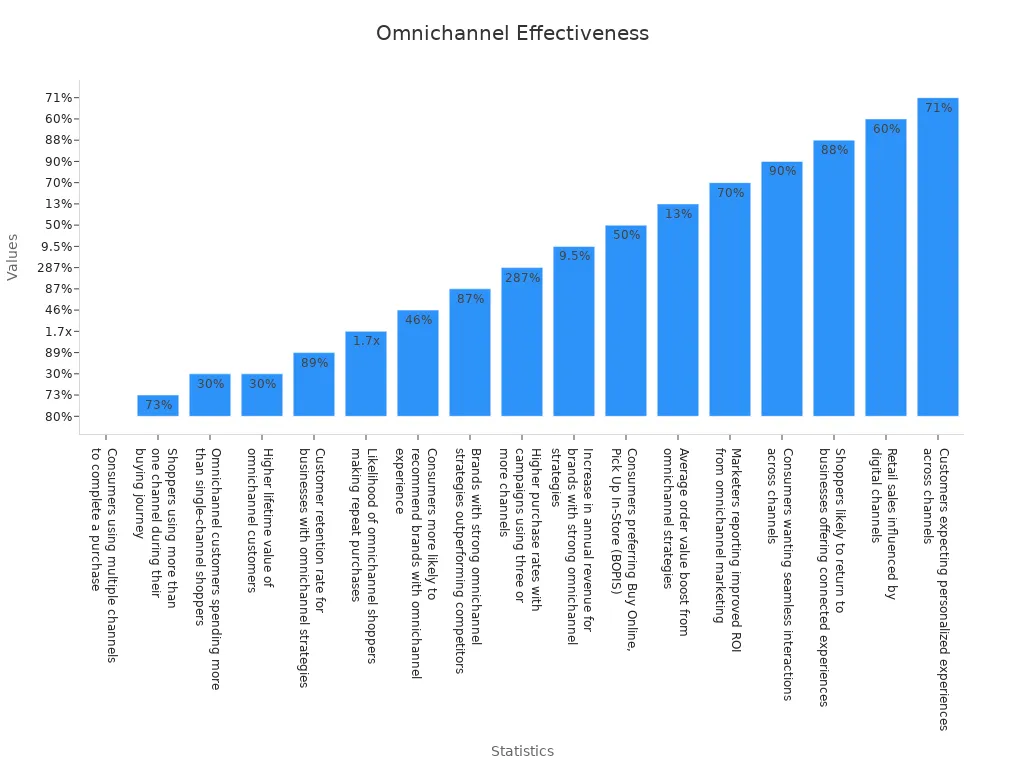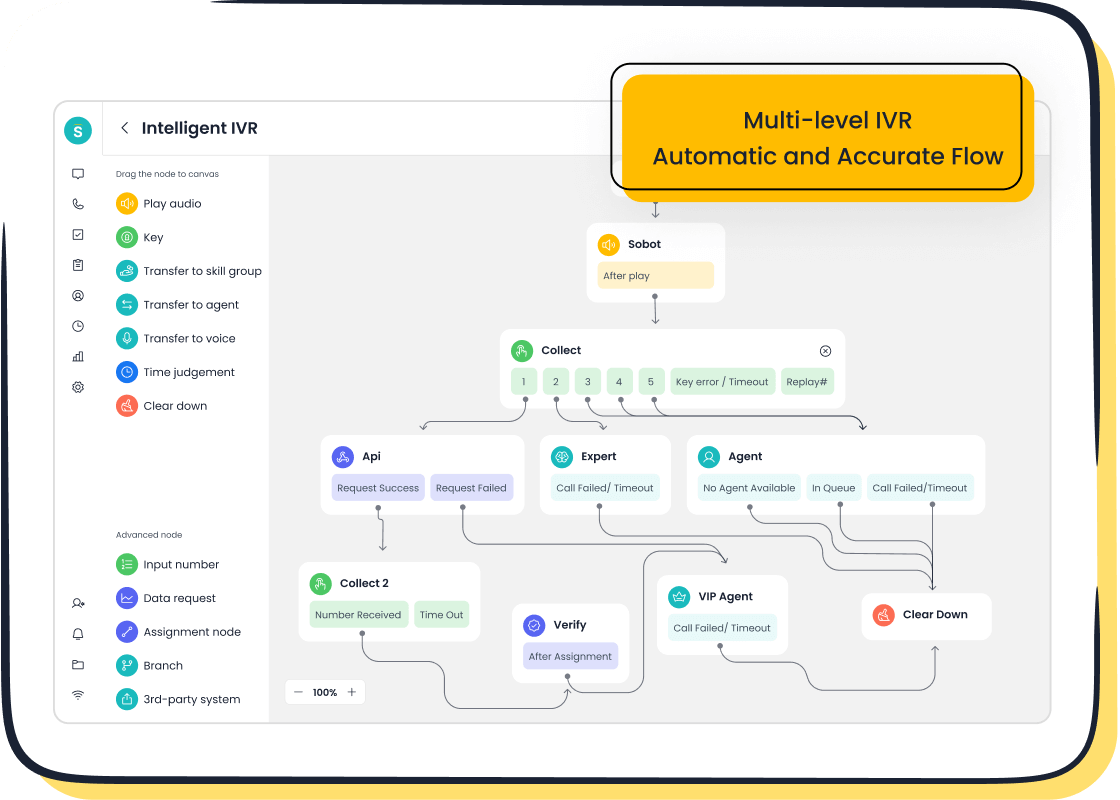What Is Omnichannel Customer Service and Why It Matters

Omnichannel customer service examples demonstrate how to ensure seamless support across multiple platforms, creating a unified experience for your customers. Whether they interact via email, social media, or phone, they receive consistent service. This approach not only meets customer expectations but also drives business success. For instance:
- Omnichannel customers spend 4% more in-store and 10% more online than single-channel users.
- Businesses with strong omnichannel strategies retain 89% of their customers, compared to 33% for weaker approaches.
Sobot’s solutions, like its omnichannel platform, help businesses achieve these results by integrating communication channels into one efficient system.
What Is Omnichannel Customer Service?
Definition and Key Features
Omnichannel customer service refers to a strategy that connects all communication channels into a single, seamless system. It ensures that customers receive consistent support, whether they contact you through email, social media, live chat, or phone. This approach focuses on creating a unified customer journey, where every interaction feels connected and personalized.
Key features of omnichannel customer service include:
- Integrated experience: All channels work together to provide a smooth transition between platforms.
- Unified data: Customer information is centralized, allowing agents to access past interactions instantly.
- Personalization: Tailored responses based on customer history and preferences.
- Automation: AI-powered tools like chatbots handle repetitive tasks, freeing up agents for complex issues.
Sobot’s omnichannel solution exemplifies these features. It integrates tools like live chat, voice call centers, and WhatsApp API into one platform, enabling businesses to deliver an exceptional omnichannel customer experience.
How Omnichannel Customer Service Works
Omnichannel customer service works by unifying all communication channels into a single system. When a customer reaches out, the system tracks their interactions across platforms. For example, if they start a conversation on social media and later call your support team, the agent can see the entire history. This eliminates the need for customers to repeat themselves, improving satisfaction.
AI and automation play a significant role. Tools like Sobot’s AI-powered chatbots handle common queries, while intelligent routing directs complex issues to the right agents. Real-time analytics provide insights into customer behavior, helping you optimize your service strategy.
The effectiveness of this approach is evident in the numbers:
| Statistic | Value |
|---|---|
| Customer satisfaction rates for omnichannel businesses | 23 times better |
| Percentage of customers annoyed by repeating issues | 89% |
| Percentage of sales generated by omnichannel customers | 27% |
| Expected value of omnichannel retail commerce market by 2023 | $11.01 billion |
Omnichannel Customer Service Examples
Omnichannel customer service examples highlight how businesses create a seamless experience. Imagine a customer browsing your website and adding items to their cart. They abandon the cart but later receive a reminder via email. When they respond, a live chat agent picks up the conversation where it left off. This continuity builds trust and encourages purchases.
Sobot’s solutions make this possible. For instance, its unified workspace consolidates customer data, enabling agents to provide personalized support. Companies like Opay have used Sobot’s omnichannel platform to increase customer satisfaction from 60% to 90%, demonstrating the power of an integrated approach.
Omnichannel vs. Multichannel Customer Service
What Is Multichannel Customer Service?
Multichannel customer service allows you to interact with customers across various platforms, such as email, social media, and phone. Each channel operates independently, meaning there is no integration between them. For example, if a customer emails your support team and later calls, the agent may not have access to the email conversation. This lack of connection can lead to repetitive interactions and frustration.
While multichannel service gives customers the freedom to choose their preferred platform, it often lacks the consistency and personalization that modern customers expect. Businesses using this approach may struggle to provide a cohesive customer experience, as data and communication remain siloed.
Key Differences Between Omnichannel and Multichannel
Understanding the differences between omnichannel and multichannel strategies helps you choose the right approach for your business. The table below highlights key distinctions:
| Feature | Multichannel Strategy | Omnichannel Strategy |
|---|---|---|
| Approach | Engages customers across multiple, separate channels | Provides a cohesive experience across all channels |
| Customer Choice | Offers freedom in channel selection | Ensures consistency and personalization across choices |
| Operations | Channels operate independently | Integrated and unified channel operations |
| Experience | Can lead to disjointed experiences | Seamless and integrated customer journey |
| Data Use | Limited use of shared customer data across channels | Utilizes comprehensive data for personalized interactions |
Omnichannel customer service integrates all channels into a unified system, ensuring a seamless experience. In contrast, multichannel service keeps channels separate, which can result in fragmented interactions.
Why Omnichannel Provides a Better Customer Experience
Omnichannel customer service enhances the customer experience by creating a unified journey. Every interaction feels connected, whether a customer switches from live chat to a phone call. This approach eliminates the need for customers to repeat themselves, reducing frustration.
Here’s why omnichannel stands out:
- It personalizes support by leveraging customer data to understand preferences and needs.
- It streamlines communication, enabling faster issue resolution.
- It ensures consistency across all platforms, building trust and loyalty.
For example, 91% of contact center professionals prioritize omnichannel integration to improve customer experience. Customers now interact with brands across more than 20 channels on average, making a cohesive strategy essential. Sobot’s omnichannel solution exemplifies this by integrating tools like live chat, voice call centers, and WhatsApp API into one platform. This integration allows businesses to deliver personalized and efficient service, as seen in Opay’s success story, where customer satisfaction increased from 60% to 90%.
Benefits of Omnichannel Customer Service

Benefits for Customers
Omnichannel customer service transforms the way customers interact with businesses. It provides a seamless shopping experience by connecting all communication channels into one unified system. This approach ensures that customers can switch between platforms without losing context, saving time and reducing frustration.
Key benefits for customers include:
- Flexibility: Customers can choose their preferred communication channel, whether it’s email, live chat, or social media.
- Consistency: A consistent customer experience across all platforms builds trust and loyalty.
- Personalization: Businesses can tailor responses based on customer history, creating a more engaging interaction.
- Convenience: Customers no longer need to repeat themselves, as agents have access to their entire interaction history.
For example, 89% of buyers who experience the best omnichannel engagement become loyal consumers. This highlights how omnichannel support enhances customer satisfaction and fosters long-term relationships.
Benefits for Businesses
Omnichannel customer care doesn’t just benefit customers—it also drives significant advantages for businesses. By integrating all communication channels, companies can streamline operations and improve efficiency.
| Benefit Type | Description |
|---|---|
| Deeper Engagement | Businesses can proactively engage customers across various touchpoints, strengthening relationships. |
| Comprehensive Data Insights | Unified data tracking provides a holistic view of customer behavior and preferences. |
| Improved Efficiency | Seamless transitions between channels reduce customer effort and increase satisfaction. |
| Competitive Advantage | Exceptional service differentiates businesses in a customer-centric market. |
Businesses with omnichannel strategies report customer satisfaction rates that are 23 times higher than those without. This approach also reduces operational costs by automating repetitive tasks and optimizing agent workloads. Sobot’s omnichannel solution, for instance, helps businesses achieve these results by integrating tools like live chat, voice call centers, and WhatsApp API into one platform.
Real-World Success Stories (e.g., Sobot and Opay)
The impact of omnichannel customer service is evident in real-world examples. Take Opay, a leading financial service platform, which partnered with Sobot to enhance its customer interactions. By implementing Sobot’s omnichannel solution, Opay integrated social media, email, and voice channels into a single system. This allowed them to manage customer inquiries seamlessly and improve service delivery.
The results were remarkable:
- Customer satisfaction increased from 60% to 90%.
- Operational costs dropped by 20%.
- Conversion rates rose by 17%.
Sobot’s intelligent IVR system also enabled 60% of Opay’s customers to resolve issues independently, reducing the workload on agents. These outcomes demonstrate how omnichannel support can drive enhanced customer satisfaction and operational efficiency.
Why Omnichannel Customer Service Is Essential in Modern Business
The Rise of Digital-First Customers
Modern retail has shifted dramatically with the rise of digital-first customers. These individuals prioritize online interactions and expect seamless transitions between digital and physical channels. Businesses that fail to meet these expectations risk losing customer engagement. For instance, digital-first customer journeys have been shown to increase satisfaction by 25% and boost customer retention by 20%.
You can see this trend in the growing adoption of conversational AI, which reduces response times by 50% and cuts support costs by 40%. Tools like Sobot’s omnichannel solution help businesses cater to these digital-first customers by integrating real-time data and offering personalized experiences. This omni-channel approach ensures that your customers feel valued, no matter how they interact with your brand.
Personalization and Customer Retention
Personalization is no longer optional—it’s essential for improved retention and long-term loyalty. Customers expect businesses to understand their preferences and provide tailored solutions. Studies reveal that 62% of consumers lose loyalty when brands fail to deliver personalized experiences. On the other hand, omni-channel strategies that prioritize personalization boost customer retention by 89%.
Sobot’s unified workspace enables your team to access customer data instantly, allowing for a truly personalized experience. Whether through live chat, email, or voice, this omni-channel approach ensures every interaction feels meaningful. By investing in personalization, you not only enhance customer satisfaction but also build a foundation for long-term loyalty.
Statistics and Trends Supporting Omnichannel Strategies
The effectiveness of successful omnichannel strategies is backed by compelling statistics. For example:
| Statistic | Value |
|---|---|
| Consumers using multiple channels to complete a purchase | 80% |
| Omnichannel customers spending more than single-channel shoppers | 30% |
| Customer retention rate for businesses with omnichannel strategies | 89% |
| Higher lifetime value of omnichannel customers | 30% |
| Likelihood of omnichannel shoppers making repeat purchases | 1.7x |
These numbers highlight why an omni-channel strategy is crucial for modern businesses. Customers increasingly demand seamless interactions across platforms, with 90% expecting connected experiences. Sobot’s omni-channel customer service tools, such as its AI-powered voice call center and WhatsApp API, empower businesses to meet these expectations. By adopting an omni-channel approach, you can stay ahead in today’s competitive landscape.

Tools and Best Practices for Implementing Omnichannel Customer Service

Essential Tools and Technologies (e.g., Sobot Voice/Call Center)

Implementing an omnichannel strategy requires the right tools to ensure seamless transitions and efficient service. Tools like Sobot’s Voice/Call Center play a pivotal role in enhancing omni-channel customer service. This platform integrates features such as intelligent IVR, AI-powered voicebots, and global number availability, enabling businesses to deliver consistent support across channels. For example, Sobot’s unified workspace allows agents to access customer data instantly, ensuring personalized interactions.
Statistics highlight the effectiveness of such tools:
| Metric | Value |
|---|---|
| Customer satisfaction rate | 95% |
| Positive feedback rate | 96%+ |
| Self-service question resolution | 22.2% |
| Problems solved | 85% |
These tools not only improve customer satisfaction but also reduce inbound discussion volume by 20%, allowing your team to focus on complex issues. By leveraging advanced technologies, you can streamline operations and enhance the overall customer experience.
Steps to Build a Seamless Omnichannel Experience
Building a seamless omni-channel customer service experience involves strategic planning and execution. Follow these steps to ensure success:
- Understand customer needs through surveys and data analysis.
- Use insights to make customer-centric decisions.
- Train employees to manage interactions consistently across all channels.
- Implement real-time communication tools like live chat and chatbots.
- Continuously collect feedback to refine your strategy.
- Measure success using KPIs such as customer satisfaction and retention rates.
For instance, Sobot’s omnichannel solution integrates tools like WhatsApp API and live chat, enabling businesses to provide real-time support. This approach ensures seamless transitions between platforms, reducing customer frustration and boosting loyalty.
Overcoming Common Challenges in Implementation
Implementing an omnichannel strategy comes with challenges, but you can overcome them with the right approach. Seamless data integration across channels is essential to avoid inefficiencies. Personalization plays a critical role in enhancing customer satisfaction, while structured processes prevent chaos in managing interactions.
To address these challenges:
- Invest in infrastructure to unify customer touchpoints.
- Ensure data privacy and security to maintain trust.
- Adapt continuously to evolving consumer behavior and technology trends.
For example, Sobot’s omnichannel platform consolidates customer data into a unified workspace, simplifying management and improving efficiency. By addressing these challenges proactively, you can create a robust omni-channel customer service system that meets modern expectations.
Omni-channel customer service has become a cornerstone of modern business success. By unifying communication channels, it ensures seamless and personalized interactions that enhance customer satisfaction and loyalty. Businesses adopting this approach see measurable benefits, such as higher retention rates and increased sales.
For example:
- Integrated technology and data management improve customer satisfaction, leading to better engagement.
- Managing experiences across multiple touchpoints boosts loyalty and prevents customer loss.
Sobot’s omni-channel customer service tools, like its Voice/Call Center and unified workspace, empower you to deliver consistent and efficient support. These solutions simplify operations and help you meet evolving customer expectations.
Adopting an omnichannel strategy positions your business to stay competitive in a customer-centric market. Start transforming your service approach today to build lasting relationships and drive growth.
FAQ
What is the difference between omnichannel and multichannel customer service?
Omnichannel customer service integrates all communication channels into one system, ensuring a seamless experience. Multichannel service, on the other hand, operates channels independently, often leading to fragmented interactions. For example, Sobot’s omnichannel solution unifies platforms like live chat, email, and voice, creating a consistent journey for your customers.
How does omnichannel customer service improve customer satisfaction?
Omnichannel service eliminates repetitive interactions by unifying customer data. Agents access past conversations instantly, providing personalized support. For instance, Sobot’s unified workspace ensures agents deliver faster resolutions, boosting satisfaction. Studies show businesses with omnichannel strategies retain 89% of customers, compared to 33% for weaker approaches.
What tools are essential for implementing omnichannel customer service?
Key tools include AI-powered chatbots, unified workspaces, and intelligent IVR systems. Sobot’s Voice/Call Center integrates these features, enabling seamless transitions across channels. With tools like WhatsApp API and live chat, you can provide real-time support and enhance customer experiences.
Why is personalization important in omnichannel customer service?
Personalization builds trust and loyalty. Customers expect tailored solutions based on their preferences. Sobot’s omnichannel platform uses centralized data to deliver personalized interactions. Research shows 62% of consumers lose loyalty when brands fail to personalize, while omnichannel strategies boost retention by 89%.
How can businesses measure the success of their omnichannel strategy?
Track metrics like customer satisfaction (CSAT), retention rates, and resolution times. Sobot’s analytics tools provide real-time insights, helping you optimize operations. For example, Opay increased customer satisfaction from 60% to 90% using Sobot’s omnichannel solution, showcasing measurable success.
See Also
Essential Tips for Choosing Omnichannel Call Center Tools
A Comprehensive Guide to Deploying Omnichannel Contact Centers
Best Cloud-Based Contact Center Services Reviewed for 2024